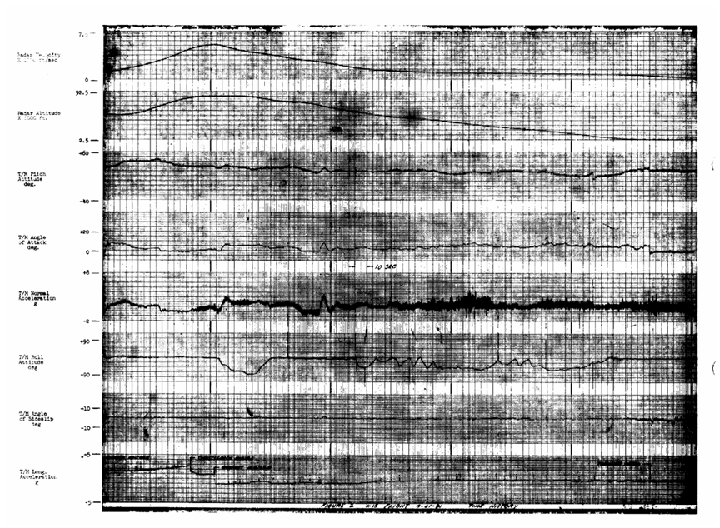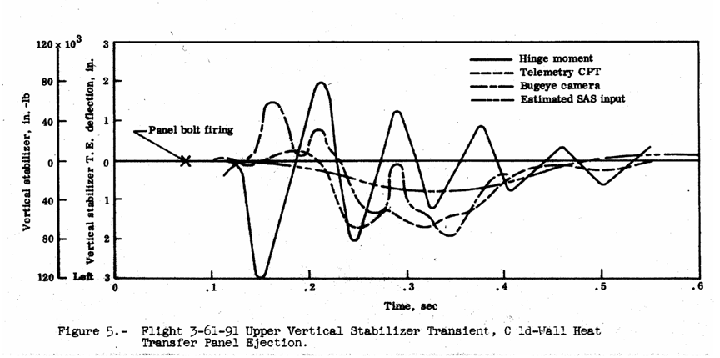
August 2, 1967
MEMORANDUM for Assistant Chief, Research Projects
Subject: Preliminary report on X-15 flight 3-61-91
Summary
Flight 3-61-91 was
flown on July 20, 1967, by William Dana for the purpose of obtaining data
for:
a. Cold-Wall Heat
Transfer.
b. Surface roughness Heat Transfer (Wavey Panel).
c. Boost Guidance Checkout.
d. Horizontal Stabilizer Loads.
e. Upper Vertical
Stabilizer Hinge Moment Measurement.
The maximum velocity
was 5400 fps (3682 mph and a Mach number of 5.51) at an altitude of 84,000
feet. The maximum altitude reached during the flight was 84,000 feet.
Acceptable data were obtained on all experiments except Boost Guidance and portions of the Cold-Wall Heat Transfer experiment. The Boost Guidance program could not be initiated because an instruction in memory had been altered, causing the ALERT computer to malfunction. An investigation to determine the cause of loss of pressure and skin friction data, for the Cold Wall Heat Transfer experiment is in progress.
There were no major malfunctions during this flight.
Flight Track and Profile
The radar track and profile for this flight are shown in figure l. The ground track showed launch approximately 2.5 nautical miles south of the planned launch point. A heading correction initiated just after launch resulted in the ground track being essentially on the planned track (less than a mile) at burnout.
The flight profile shown in figure l was higher than planned from the time the planned pitch attitude was attained until a pushover maneuver was initiated just after engine burnout. This discrepancy was caused by an incorrect presentation of pitch attitude to the pilot. Because of this discrepancy the profile was approximately 2000 feet higher than planned at the cold-wall heat transfer and peak altitude points.
Stability and Control
A time history of the significant stability and control parameters telemetered during the flight is shown in figure 2. The launch was from Hidden Hills Lake #l at an indicated airspeed of 224 knots, Mach number of 0.82 and an altitude of 45,000 feet on a heading of 240.5 degrees. Launch was normal with 17° of right roll and 4° of sideslip. Engine light occurred 1.1 seconds after launch and reached 100 percent thrust in 0.7 seconds. Rotation after launch initially peaked at 11.5° angle of attack then lowered to a 9.5 average, as compared to the planned 10°, until a pitch attitude of 20° was attained in 17.7 seconds. The maximum normal acceleration during rotation was 1.8 g.
The pitch attitude, shown in the time history, is invalid because of a zero and calibration shift which occurred prior to takeoff. Cockpit film showed the planned pitch attitude of 20° was obtained and held as planned, however, there was a discrepancy in pitch attitude presentation to the pilot. The three axis attitude indicator indicated 20°, the theta vernier was indicating 17°, and when the pilot switched to precision attitude presentation the needles were nulled, thus indicating the proper pitch attitude (20°).
The pilot initiated a pushover maneuver to 0 "g" as planned at 59,000 feet. At this point indications were that the profile would be higher than planned. In an effort to correct this, the pilot retarded the throttle but data shows this did not change the chamber pressure because the throttle movement was within the dead-band area and resulted in no thrust change. No other corrective measures were taken.
Engine throttle back to minimum thrust occurred at 4700 fps and the speed brakes opened to 35° as planned. The panel was ejected at a velocity of about 5100 fps with the dynamic pressure approximately 1010 psf. Engine burnout occurred at 5400 fps after 92.1 seconds of powered time. During the glide back to Edwards a horizontal stabilizer loads maneuver was performed and computed angle of attack and angle of sideslip were checked. The approach, landing, and rollout were normal. The pilot executed an unassisted exit from the aircraft after completing post-landing checks.
A time history of the airplane weight is shown in figure 3, and of the longitudinal center-of-gravity position is shown in figure 4. The calculated landing weight was 15,200 lbs with a longitudinal center-of-gravity position of 22.3 percent of the mean aerodynamic chord.
Cold-Wall Heat Transfer
Partial data were obtained on this experiment. Preliminary analysis shows usable data were obtained only from the thermocouple instrumentation. The pressure data are unusable because of excessive noise. No usable data were obtained on the skin friction gage. Investigation of the cause of these discrepancies are in progress. No further cold-wall heat transfer flights are planned until these discrepancies are resolved.
The preliminary panel ejection conditions were:
h » 78,000 feet
v » 5100 fps
q » 1010 psf
The panel ejection film, showing the upper vertical stabilizer, showed the stabilizer oscillated with an amplitude and frequency similar to that of flights 3-59-89 and 3-60-90. An analysis of this phenomenon is discussed in the upper vertical stabilizer hinge-moment measurement section.
Surface Roughness Heat Transfer
A wavey surface roughness panel was installed for heat transfer data on this flight.
The flight fulfilled the data requirements for this experiment and the panel will be removed before the next flight.
A review of the data shows that acceptable data were obtained. A detailed analysis of all data obtained for this experiment is in progress.
Boost Guidance Checkout
The Ames Research Center's Boost Guidance experiment was programmed in the ALERT computer for this flight. However, this program could not be initiated because an instruction in memory had been altered, causing the ALERT computer to malfunction. This discrepancy has been corrected and the experiment will be flown on the next flight.
Horizontal Stabilizer Loads
A horizontal stabilizer loads maneuver was performed during the glide portion of this flight at approximately 2.5 Mach number. The conditions for this maneuver were:
Initial Pullup Pushover
Time 0.0 3.9 sec 0.7 sec
Alpha 0.5° 10.5° 0.5°
An -0.2g 3.0g -0.4g
Beta 0.0 2.3° 0.0
The pilot reported buffeting at an angle of attack of about 10° to 10.5° during this maneuver and, therefore, limited the pullup maneuver to 10.5 degrees angle of attack.
This flight concluded the Phase I portion of the Horizontal Stabilizer Loads Study. A completely instrumented horizontal stabilizer with thermocouples and additional strain gages will be installed for the next flight to begin the Phase II portion of the study.
Upper Vertical Stabilizer Hinge-Moment Measurement
Films of cold-wall heat transfer panel ejection during flights 3-59-89 and 3-60-90 have shown that an oscillation of the upper vertical occurs at this point causing concern about exceeding the design limit of 120,000 in.-lb moment of the upper vertical during this phenomenon. To obtain additional data, strain gages to measure hinge moment were installed and recorded during this flight. A plot of the analysis of flight data are shown in figure 5. From these data the maximum hinge moment measured was approximately 121,000 in.-lbs and 70,000 in.-lbs at a frequency of 11.6 cps.
A comparison of this data with previous flight data indicates that the largest hinge moments occurred during the blowoff panel ejection.
A detailed analysis of the flight data is in progress in an effort to determine as accurately as possible the loads sustained on the upper vertical by the ejection of the cold-wall heat transfer panel.
Data Systems Discrepancies
The pilot commented that during the rotation there was a 0.2 g discrepancy between the mechanical "g" meter and the tape "g" presentation. The mechanical "g" meter was indicating 1.6 g which correlated with the planned "g" during rotation and the tape readout was 1.8 g.
During the boost portion of the flight, the pilot was required to attain a planned pitch attitude of 20°. As the pilot reached 20° pitch attitude on the three axis indicator, the readout on the theta vernier was only 17 degrees. In an effort to validate one of the indications, the pilot switched to the precision attitude display. These were indicating a nulled position, verifying the planned pitch attitude was being flown, and that a discrepancy may exist in the theta vernier readout.
The following discrepancies were noted on the PCM Sub-Commutator:
Ch. 1-63 Pitch attitude showed a +20° offset prior to launch.
Ch. 1-64 Roll attitude was slightly nonlinear for this flight.
Ch. 1-67 The normal accelerometer was showing +0.5g noise during flight.
Ch. 1-70 Just prior to landing the 12V Neff became offset.
Ch. 3-70 The L/H tip pod T/C (skin) indicated a saturated condition.
Ch. 4-36 The Mach probe showed a shift prior to landing.
Channel 54 on the
Prime Commutator: Normal acceleration was erratic for this flight.
(James R. Welsh - for)
E. J. Adkins, Chief
X-15 Research Project
Office




